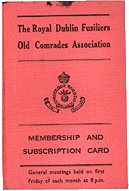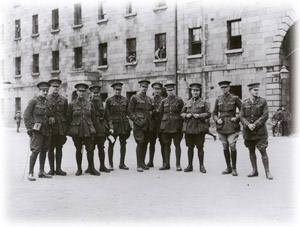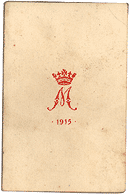In Ireland, the period leading up to the Great War was highly charged politically. Unionists mobilized as the Ulster Volunteer Force to oppose the introduction of Home Rule, which had passed through Parliament in 1914 and awaited Royal assent. The Irish Volunteers movement formed in response and both groups drilled openly. A bloody civil war seemed imminent, but the threat was temporarily diffused when Britain declared war on Germany and postponed the introduction of Home Rule.

RDF Old Comrades Association subscription card.
There were also considerable economic pressures in Ireland, with widespread unemployment and appalling living conditions. Very little industrial development had taken place and the economy was still largely dependent on agriculture. In Dublin, the eight-month lockout of workers which began in 1913, piled additional pressure on the impoverished.
In September 1914, there were five armed military groups on the island: the British Army, the Ulster Volunteers, the Irish National Volunteers, the Irish Republican Brotherhood (IRB) and the Citizens’ Army (organized to protect unionised workers during the 1913 lockout).
Both Edward Carson, the Unionist leader, and John Redmond, leader of the Irish Party, used the same argument to persuade their supporters to join the British Army: that by showing loyalty in wartime, their sacrifice would be rewarded by Westminster acceding to their political demands. The lure of a steady wage and a separation allowance for married men also enticed many to enlist. Over 200,000 Irish people served in the allied forces in the Great War, about 30,000 from Dublin alone.
Political Scene: Ulster Volunteer Force
Home Rule had been on the agenda even before the end of the 19th century. After the 1910 General Election, the Irish Party held the balance of power and a Dublin parliament seemed possible. Sir Edward Carson, the Unionist leader, began organizing resistance to Home Rule. Demonstrations were held throughout Ulster and in 1912, Andrew Bonar Law, Conservative Party leader, pledged support for the Unionist cause. Unionists drew up an anti-Home Rule document, ‘Ulster’s Solemn League and Covenant,’ subscribed to by 471,314 people, some men signing in their own blood. Men and women signed separate covenants.

D Company Officers photographed at Royal/ Collins Barracks.
The Ulster Volunteer Force was founded on January 13, 1913. Orange Lodges and Unionist clubs provided a community-based structure for the movement and their facilities were used for drilling. On April 24, 1914, the UVF landed 24,600 rifles and 3 million rounds of ammunition at Bangor and Larne. The arms came from Germany and Italy, though many disliked the Italian guns on the grounds that the word ‘Annunciata’ stamped onto some of them could be mistaken for a papal blessing!
Blatant displays of illegal resistance were ignored by the police. One in three Ulstermen joined the UVF and army veterans carried out training. The Army also lent much support, with 59 officers, led by Brigadier General Hubert Gough, threatening to resign rather than carry out orders against the UVF. This became known as the Curragh Mutiny.
What of the men of Ulster?
Hark to the armed tread,
As they turn their backs on the Province,
And face to the front instead
The sword half drawn on her own behalf
In Ulster’s Red Right Hand
Will leap from scabbard and flash like fire
For the common Motherland.
And wherever the fight is hottest,
And the sorest task is set,
Ulster will strike for England,
And England will not forget.
– A poem of the time.
Click here to download more about this
Irish Volunteers
3,000 Irish National Volunteers enlisted at the inaugural meeting on November 25, 1913. Peaking in September 1914, membership reached 191,000. Not all were extremists, but key positions were occupied by twelve Irish Republican Brotherhood members, unknown to the Volunteers’ president, Professor Eoin Mac Neill. Like the UVF, the Irish Volunteers organized on a local basis, drilling being directed by army veterans.
An uneasy alliance with the Irish Parliamentary Party was made in 1914. At a conference at Buckingham Palace in July, Prime Minister Asquith, Carson and Redmond could not agree about excluding Ulster from Home Rule and the prospect of partition galvanized many nationalists.
Tom Kettle travelled to Belgium to negotiate the purchase of German arms. (Seeing the Germans occupy Belgium influenced his joining the British Army.) Erskine Childers captained The Asgard, from which about 900 rifles and 29,000 rounds of ammunition were landed at Howth in late July. Some of the King’s Own Scottish Borderers was ordered to intercept the landings, but were stoned by civilians. They opened fire, killing three.
In the House of Commons, John Redmond denounced the killings:
“Let the house clearly understand that four fifths of the Irish people will not submit any longer to be bullied, or punished, or shot, for conduct which is permitted to go scot-free in the open light of day in every county in Ulster by other sections of their fellow countrymen.”
About a week later, another 600 rifles were landed in Wicklow. Following John Redmond’s speech at Woodenbridge, Co. Wicklow, the Volunteer movement split. Those supporting Redmond’s call to join up for the war were the National Volunteers. 13,500 led by MacNeil, called themselves the Irish Volunteers. Irish troops departing for the war, were cheered by crowds of well-wishers, except for the King’s Own Scottish Borderers.
Click here to download more about this
Irish Economy
Most of the industrial development in Ireland was in Ulster – the seat of resistance to Home Rule. Elsewhere, the economy was poorly developed and depended greatly on agriculture.

A Chrismas card of
the era.
Dublin had some of the worst slums in Europe with over 21,000 families living in single rooms in tenement buildings, the highest death rate at birth (27.6 per 1,000) and the highest death rate of densely populated centres in the UK. According to a 1914 Government report, 14% of Dublin’s population lived in houses declared unfit for human habitation and said that many others, ‘scarcely deserve the name house and could be more aptly described as shelters.’
This situation was intensified in 1913 when 400 employers, organized by William Martin Murphy, locked out workers who were members of the Irish Transport & General Workers’ Union, led by Jim Larkin and James Connolly. 24,000 workers were not able to earn their wage and many more depended on that money. Dublin witnessed massive rallies, baton charges and riots.
Dublin proved a fertile recruiting area – double the national average and outstripping even Belfast. Many people emigrated to work in munitions factories and shipyards. A regular wage was very attractive and everyone believed that the war would be over by Christmas.